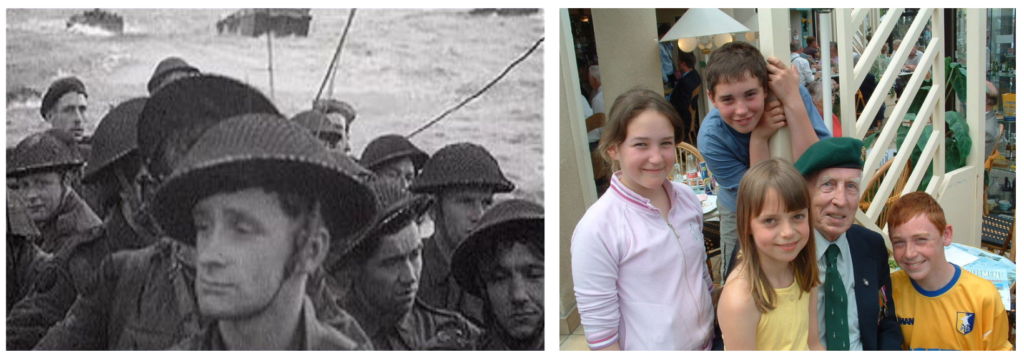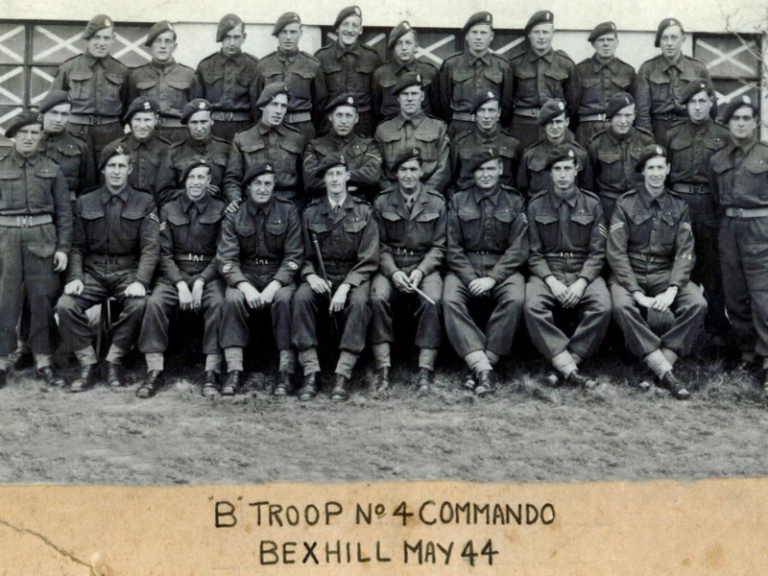Between late 1943 and the early spring of 1944 Bexhill homes provided billets for the officers and men of the A and B Troops of 4 Commando. About a hundred men or so, joined by Free French soldiers from the 10th Inter-Allied Commando unit, they trained, paraded, partied and prayed around the town as young soldiers did. No-one would say, but everyone knew. They were just passing through, on the way to France and the long-awaited invasion of Europe.
In what had become common practice for the Commandos, the soldiers were individually billeted in Bexhill homes rather than barracked, often bringing their weapons with them. Many were battle handed veterans of months of commando raids on the French coast, including the bloody raid on Dieppe in August 1942, largely a failure but an important tactical learning experience ahead of D-Day itself.
The pictures of the two units come from websites and message boards started by amateur historians years ago. The detail has been filled in by families of the men along with photos of the veterans at the various post-war reunions in Normandy. But what happened to them once 4 Commando left Bexhill?
The various Troops of 4 Commando had been spread along the coast from Bexhill and Newhaven to St Ives and Weymouth until they moved out on 25 May – without a word – to four sealed off camps on Southampton Common. The soldiers were locked inside the camps before boarding two transport ships, the Princess Astrid and the Maid of Orleans. Only once on board they were briefed on their role on the day.
The men of 4 Commando, about five hundred strong, would land in two waves on Sword Beach, on Queen Red sector at La Beche, a mile to the west of Ouistreham harbour. A brigade of county regiments were to land at 7.50am and hold the beach for the commandos who would land at 8.20am and pass through their lines to capture a large gun emplacement overlooking the beach.
From there they would join up with other Commando units under the command of Simon Fraser, the Lord Lovat, and advance to a bridge over the Caen Canal at Bénouville, to be captured by a glider borne force in a fiercely precise night attack. Their job would be to relieve the airborne forces holding the crossing – better known today as Pegasus Bridge.
In the photo of B Troop in Bexhill above you can see Private Joe Burnett, fourth from the left in the middle row. A Tynesider, he also appears in some of the most iconic images of WWII. Below, front far left, pictured returning to Newhaven exhausted after the Dieppe raid, and in the background of a movie still, at the bottom of this page, from the famous newsreel clip of 4 Commando about to land on Sword Beach, the man at the back in a beret.
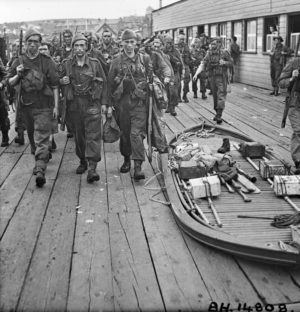 In the front row of the Bexhill picture of B Troop, its senior officer, the impressively named Lieutenant Edward Lionel Knyvet Augustus Carr, or more usually Knyvet Carr, or among friends, ‘Muscles’, for his slight wiry frame. At Dieppe his team achieved one of the few successful phases of the battle, cutting the communications of a lighthouse used as an observation point over the landing beaches.
In the front row of the Bexhill picture of B Troop, its senior officer, the impressively named Lieutenant Edward Lionel Knyvet Augustus Carr, or more usually Knyvet Carr, or among friends, ‘Muscles’, for his slight wiry frame. At Dieppe his team achieved one of the few successful phases of the battle, cutting the communications of a lighthouse used as an observation point over the landing beaches.
His modest account of D-Day is striking. B Troop were tasked to carry the heavier weaponry – three-inch mortars, large machine guns and substantial amounts of ammunition – 70lbs of kit in their bergen rucksacks and a 10lb mortar shell each. He made it across the beach under fire and took out a gun emplacement singlehanded.
“As I moved across the beach I was hit three times, twice on my hand and wrist by small splinters and once on my rucksack, but not seriously. As I came up to the strong point a German soldier behind it threw two stick grenades into the air which exploded harmlessly behind me. He was immediately shot, and the strong point was captured.”
As other commandos moved in to seize the Ouistreham gun emplacements and Bexhill’s French commandos took the harbour’s casino – a feat of arms recreated on the original spot in a single shot in the film The Longest Day – Carr’s men used captured carts to move their heavy mortars towards Benouville and the iconic Pegasus Bridge.
They quickly followed Lord Lovat’s First Special Service Brigade, among them one Bill Millen of A Troop 4 Commando, also billeted in Bexhill before D-Day. He has a case for being one of the most famous characters of D-Day. He played bagpipe classics like The Road to the Isles and All The Blue Bonnets Are Over The Border during the landing on Sword Beach, where alone among the invading British forces he wore a kilt. Millen played again again at Lovat’s request as the Commandos crossed Pegasus Bridge to relieve the glider troops, another scene recreated (with some licence) for the film The Longest Day.
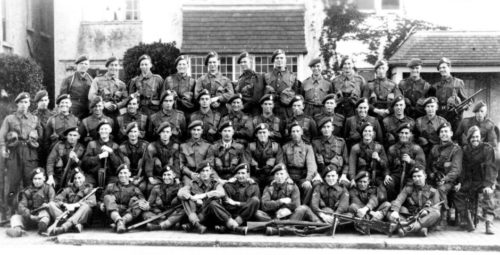
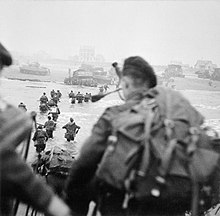
“At Bénouville we arrived at the bridge over the Caen Canal and to our relief we were greeted by paratroops,” wrote Carr. “The bridge was under intermittent sniper fire so I arranged for a quick smoke screen from one of my mortars to be put down on the bridge and we managed to get our cart and ourselves across without any casualties”.
B Troop crossed the next bridge over the River Orne without any opposition and finally arrived in the evening at the little village of Hauger after a journey of about eight miles and high enough to see the whole of the beach head, “a vast array of ships of all types and sizes, the blue sea criss-crossed with white as the small assault landing craft ferried troops ashore.”
At Hauger, night was falling, and a counterattack was expected. “In the late evening we “stood to”, a standard practice for troops in defence, for often the enemy would launch an attack just before dark, but that night, a beautiful warm night, no serious attack came. About midnight all of us not on watch collapsed into our slit trenches and fell asleep after twenty hours of continuous intense activity and danger.”
Carr, Burnett and Millen survived the war. Carr won a Military Cross in November 1944 during the battle for Walcheren Island in Holland. An artilleryman by commission he stayed in the army after the war, including a stint as military attaché to the British Embassy in then communist Romania, before retiring with the rank of Lieutenant Colonel in July 1974. He died in 2000. Millen died in 2010 aged 88 after a career as psychiatric nurse, and like Burnett, became a familiar face at the many post war reunions at Ouistreham and Bénouville. Joe Burnett died in 2010. Stephane Saint-Martin, a part-time historian in Normandy, reports that following his death, his family scattered his ashes at sea on June 6 that year, at sea off Queen Red beach, where he had landed in 1944.
